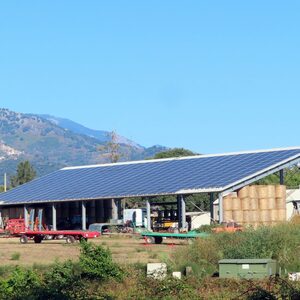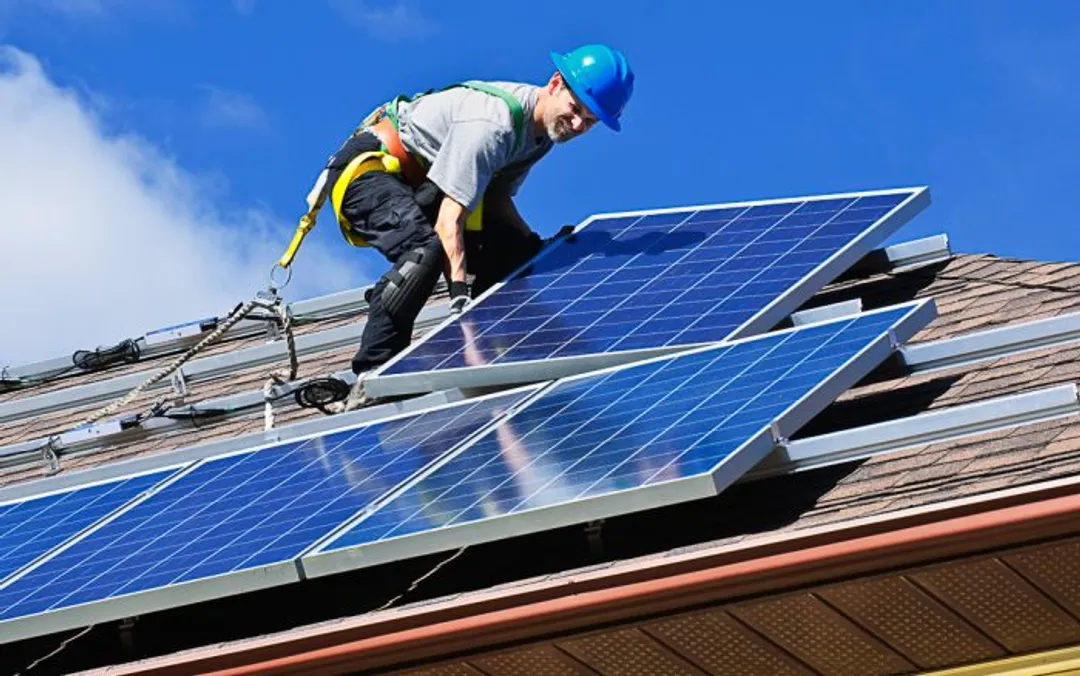
As more and more eco-minded homeowners consider ways to tap into renewable clean energy sources, on-site residential production gains appeal. Many choose to add solar arrays to their roofs; others opt for ground-mounted systems. But sometimes house orientation, roof penetrations like dormers and chimneys, tree canopy coverage, or building restrictions—as in the case of historic districts—mean subpar solar capture. Even if there is room on the property and orientation is optimal, ground mounts are often viewed as eyesores. Are there other options? Yes. Consider the timber-framed solar canopy.
SunCommon—a B Corp–certified company offering solar and other clean-energy solutions throughout Vermont and New York’s Hudson Valley region—debuted its timber-framed solar canopy in 2017. Solar canopies, which are structures topped with solar panels, can be used as carports (and EV-charging stations), patio coverings, woodsheds, and places to house large equipment and/or gardening tools and supplies, among other potential uses, all while generating energy. SunCommon has partnered with New Energy Works, an employee-owned timber-frame and design company based in New York and Oregon, to deliver timber-framed canopies in one complete energy-producing package. And the concept is catching on.
A multifaceted solution
SunCommon’s mission is to make residential energy generation accessible to more people. The company’s solar canopies can be the answer when a roof is disadvantageous to meeting energy demands, and the timber framing elevates the aesthetics of a conventional ground-mounted system. (The first iteration of the framing kit used whole timbers from WholeTrees Structures. Though beautiful, they were too niche, labor-intensive, and cost-prohibitive for customers.) Among the benefits of partnering with New Energy Works is that timber framing lends itself to production-style manufacturing, which is how these kits are produced—using computer numerical-controlled (CNC) machining with saws and routers.
It’s worth noting that a…
Weekly Newsletter
Get building science and energy efficiency advice, plus special offers, in your inbox.

This article is only available to GBA Prime Members
Sign up for a free trial and get instant access to this article as well as GBA’s complete library of premium articles and construction details.
Start Free TrialAlready a member? Log in














12 Comments
Thanks for this Kiley. It offers a great alternative to what is usually a binary choice between roof top and ground mounted arrays, both of which have downsides.
I wish we had thought of it before installing the panels at Sheringham Lighthouse a few years ago. We ended up with a sort of worst of both worlds solution.
This is a great idea, but folks still struggle with the entry costs for solar and this does not seem to help that. In fact, it adds a maintenance cost for the timber frame not required on the usual metal frames. And unless the company can hold the sun stationary for at least 4 hours daily, at least one of the example installs looks like it does not get enough direct sunlight to make it productive. You gotta cut some trees to get sufficient exposure in forested locations.
Longstory,
I'm more interested in the idea that this particular application. All it takes to make the ground mounted arrays you and I have posted useful shelters, is longer supports. The timber framing is just one of many designs that can work.
Longstory is missing the forest for the canopy, you might say.
I guess I’m saying they need some examples that show you need significant direct sun exposure to produce electricity. Shading really cuts production and this idea of reflecting onto the back of the panels seems a bit whimsical. I’d like to see some production numbers in these forest locations. I have no issues with making the mounting system attractive. I’ll grant them that. But realistically you would like 6 hours of direct sun on panels to optimize productivity and make them more cost effective. My ground mount system has over 100 ft to forest boundary on S side with more than 300 ft to E and W and I still get shading part of afternoon near the winter solstice.
That's really not the focus of the article. I don't disagree that you need sun for PV panels to work.
For what it's worth, this project is strongly net positive although it's at about 44°N latitude and less than 50' from tall trees: https://www.maines.design/portfolio/trailside-net-zero.
Michael,
I've always been uneasy about using solar orientation as a determinant for a house's roof design, or the house's location, and ground mounted arrays often take up a desirable part of the lot. Here in the wet PNW, covered outdoor space is a very desirable feature to have. If it provides power too, that's a bonus.
Malcolm, I agree--I do try to create a flat south-facing roof when possible, but sometimes other factors are more important. In other cases, like my own house, even with ideal orientation the roof isn't an ideal location because I'll need to redo my roof within 10-15 years but it doesn't need a new roof now. There's a company in my area doing "solar sheds" that are popular, providing pre-fab storage with PV panels. They aren't as attractive as the canopies that Kiley shared here but it's the same idea of doing double duty.
Question. With houses that are build to passive house or pretty good house standards how much does orientation/pitch actually matter? I imagine it matters less with a highly efficient home although generating the extra electricity to send back to the grid might be important. You also mentioned a home at 44°N latitude. What is the pitch (the correct term?) for that array?
It really depends on the glazing and shading. You don't want too much solar gain from the east, south or west, and each of those have different management techniques. If you had no windows the orientation wouldn't matter, other than for PV. The more glazing you add, and the lower-performing it is, the more orientation and shading (typically roof overhangs) matter.
New PV panels work well at low incidence angles, so orientation for them isn't as important as it used to be. I often do 10:12 pitches (about 40°) but also plenty of projects with higher or lower pitches, and find that as long as there's a pitch and it's facing somewhere near south, it doesn't matter much.
You can use this calculator to see if the same is true for your location: https://pvwatts.nrel.gov/.
“[Deleted]”
Well I guess you were right about the forest for the canopy. I thought the article was about a solar alternative. On closer inspection the construction seems to be more elven, since to work the way it needs to the location is pretty important in our world. Canopies placed like these in the article seem well suited to Middle Earth.
Log in or become a member to post a comment.
Sign up Log in